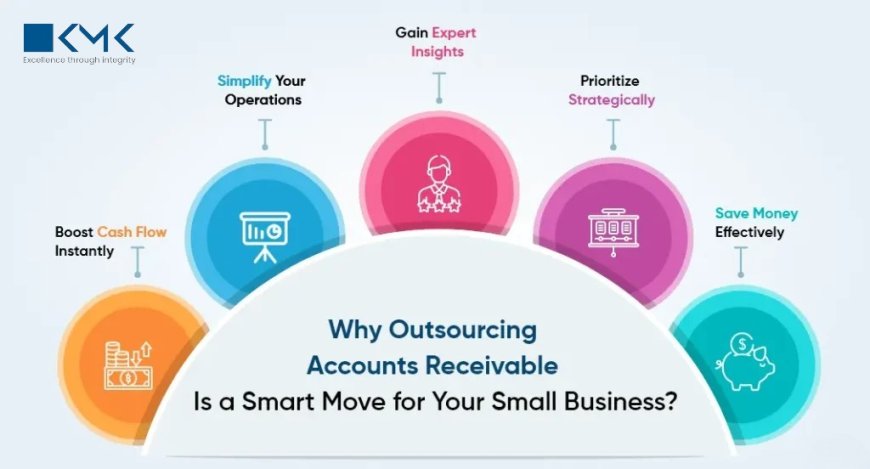US Trends in Outsourced Accounts Receivable Services for 2025
outsourced accounts receivable services to optimize processes, reduce costs, and strengthen financial performance. As we move through 2025, several trends are shaping how outsourcing providers deliver AR services and how U.S.

Accounts receivable (AR) is the backbone of healthy cash flow for U.S. businesses. Yet, in today’s fast-changing market, many companies are realizing that managing AR in-house is not always the most efficient or cost-effective option. Instead, they’re turning to outsourced accounts receivable services to optimize processes, reduce costs, and strengthen financial performance. As we move through 2025, several trends are shaping how outsourcing providers deliver AR services and how U.S. firms benefit from them. Let’s explore the biggest shifts that CFOs, controllers, and finance leaders should be aware of.
1. Increased Adoption of AI and Automation
Artificial intelligence (AI) and machine learning are no longer futuristic add-ons—they’re now at the core of outsourced AR solutions. From predicting payment delays to automating reminders, AI is helping companies reduce Days Sales Outstanding (DSO) and accelerate collections.
Providers are using AI-powered dashboards that give businesses real-time visibility into customer behavior, invoice statuses, and cash flow projections. This not only minimizes manual work but also improves accuracy and decision-making.
What this means for 2025: Businesses will increasingly seek outsourcing partners with strong AI capabilities, prioritizing providers who can offer predictive analytics and automated workflows.
2. Cloud-Based AR Platforms Become Standard
In 2025, most outsourced AR providers are delivering services through cloud-based platforms. These solutions allow U.S. companies to integrate seamlessly with existing ERP and accounting systems such as QuickBooks, NetSuite, or SAP.
Cloud adoption ensures:
-
Real-time reporting
-
Secure data sharing
-
Easier collaboration between in-house teams and outsourcing partners
With data accessible anytime and anywhere, CFOs gain better oversight while still enjoying the efficiencies of outsourcing.
3. Industry-Specific AR Solutions
Not all businesses have the same AR challenges. Retailers deal with high-volume transactions and returns, healthcare providers face complex billing and compliance rules, and manufacturers often manage long payment cycles.
In response, outsourcing providers are offering industry-tailored solutions. For instance:
-
Retail: Faster reconciliation of online and in-store payments
-
Healthcare: HIPAA-compliant billing and patient payment solutions
-
Manufacturing: Flexible credit management for B2B clients
Trend Insight: Expect to see more customization in 2025, as providers shift from one-size-fits-all models to sector-specific services.
4. Enhanced Data Security and Compliance
With cyber threats on the rise, U.S. firms are increasingly concerned about data protection. In 2025, compliance with regulations such as PCI DSS, SOC 2, and HIPAA is non-negotiable.
Outsourcing providers are investing heavily in:
-
Multi-factor authentication
-
End-to-end encryption
-
Continuous monitoring and audits
This trend not only reassures businesses but also helps them avoid penalties and reputational risks.
5. Focus on Customer Experience in Collections
Traditionally, collections were viewed as transactional. Today, businesses recognize that how receivables are managed directly impacts customer relationships. Outsourced AR providers are now emphasizing customer-friendly communication, offering flexible payment options, and resolving disputes quickly.
For U.S. firms, this means faster payments without compromising long-term client loyalty.
6. Growing Popularity Among Startups and SMEs
Previously, outsourcing AR was associated with large enterprises. But in 2025, more startups and small-to-medium-sized enterprises (SMEs) are adopting outsourcing to stay lean and agile.
Why? Because outsourcing eliminates the fixed costs of staffing and technology, allowing smaller firms to access world-class AR processes at a fraction of the cost.
7. Integration with Broader Financial Outsourcing
Outsourced AR services are no longer standalone offerings. Increasingly, they’re being bundled with accounts payable outsourcing, bookkeeping, and financial reporting services.
This trend creates a holistic financial ecosystem where U.S. firms can outsource entire finance functions, ensuring consistency, efficiency, and scalability across the board.
8. Nearshore and Offshore Partnerships Rise
While offshore outsourcing remains popular due to cost savings, many U.S. companies in 2025 are exploring nearshore options—partners in Latin America or Canada—for better time zone alignment and easier communication.
The choice between nearshore and offshore depends on a company’s priorities:
-
Offshore: Best for cost efficiency
-
Nearshore: Best for collaboration and cultural alignment
9. Stronger Performance Metrics and SLAs
CFOs want measurable results from outsourcing. Providers are now offering detailed Service Level Agreements (SLAs) with metrics such as:
-
Collection rate improvements
-
DSO reduction percentages
-
Dispute resolution turnaround time
-
Customer satisfaction scores
This transparency ensures businesses can track ROI and hold partners accountable.
10. Sustainability and ESG Alignment
Surprisingly, environmental and social governance (ESG) is now part of financial outsourcing discussions. Providers are adopting paperless invoicing, digital-first collection methods, and ethical practices to align with client ESG goals.
For U.S. firms, this means outsourcing AR can support not just financial efficiency, but also broader corporate responsibility objectives.
What US Firms Should Do in 2025
To capitalize on these trends, finance leaders should:
-
Choose providers with strong AI and cloud integration capabilities
-
Demand industry-specific AR solutions
-
Prioritize partners with proven compliance and security credentials
-
Look for transparent pricing and measurable SLAs
-
Align outsourcing decisions with long-term growth and ESG goals
Final Thoughts
The U.S. business landscape in 2025 is defined by agility, technology, and customer-centricity. Firms that outsource accounts receivable services gain more than cost savings—they also benefit from scalability, innovation, and resilience.
As trends like AI, industry-specific customization, and enhanced compliance reshape AR outsourcing, businesses that act early will position themselves ahead of competitors. For CFOs and decision-makers, the question is no longer if to outsource AR, but how soon to take advantage of these evolving solutions.



























